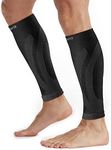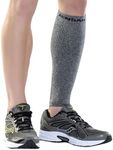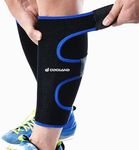Buying Guide for the Best Calf Compression Sleeves
Calf compression sleeves are a popular choice for athletes, fitness enthusiasts, and anyone looking to improve circulation or reduce muscle fatigue in the lower legs. These sleeves are designed to provide graduated compression, which can help enhance performance, speed up recovery, and prevent injuries. When choosing the right calf compression sleeves, it's important to consider several key specifications to ensure they meet your specific needs and provide the desired benefits.Compression LevelCompression level refers to the amount of pressure the sleeve exerts on your calf. It's measured in millimeters of mercury (mmHg). This spec is crucial because it determines how much support and circulation improvement you'll get. Compression levels are generally categorized into mild (8-15 mmHg), moderate (15-20 mmHg), firm (20-30 mmHg), and extra firm (30-40 mmHg). For general use and mild support, a mild to moderate level is sufficient. Athletes or those recovering from injuries might prefer firm compression for better support and faster recovery. Choose a level that aligns with your activity intensity and recovery needs.
MaterialThe material of the compression sleeve affects comfort, breathability, and durability. Common materials include nylon, spandex, and polyester blends. This spec is important because it influences how the sleeve feels against your skin and how well it wicks moisture. Lightweight, breathable materials are ideal for hot weather or intense workouts, while thicker materials might offer more warmth and support in cooler conditions. Consider your typical activity environment and personal comfort preferences when selecting the material.
Size and FitSize and fit are critical for ensuring the effectiveness of the compression sleeve. A proper fit ensures that the compression is evenly distributed and comfortable. This spec is important because an ill-fitting sleeve can either be too tight, restricting blood flow, or too loose, providing inadequate support. Sizes are usually determined by the circumference of your calf at its widest point. Measure your calf and refer to the manufacturer's sizing chart to find the best fit. If you're between sizes, consider the level of compression you prefer and whether you prioritize comfort or support.
LengthThe length of the compression sleeve determines how much of your calf and lower leg it covers. This spec is important because it affects the area of support and compression. Sleeves can vary from covering just the calf to extending over the ankle or knee. If you need targeted support for the calf, a standard length is sufficient. For additional support around the ankle or knee, consider a longer sleeve. Your specific needs, such as whether you're dealing with shin splints or ankle swelling, can guide your choice.
Design and FeaturesDesign and features include aspects like color, patterns, reflective elements, and additional support zones. While these might seem aesthetic, they can be important for visibility during low-light conditions or for matching personal style. Some sleeves also have specific zones for extra support or ventilation. If you often run or exercise in low-light conditions, reflective elements can enhance safety. Choose a design that not only appeals to your style but also meets any additional functional needs you might have.
















